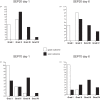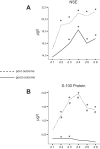Prognostic value of somatosensory evoked potentials, neuron-specific enolase, and S100 for short-term outcome in ischemic stroke
- PMID: 26745251
- PMCID: PMC4808083
- DOI: 10.1152/jn.01012.2015
Prognostic value of somatosensory evoked potentials, neuron-specific enolase, and S100 for short-term outcome in ischemic stroke
Abstract
To predict short-term outcome in acute ischemic stroke, we analyzed somatosensory evoked potentials (SEP) and biochemical parameters [neuron-specific enolase (NSE) and S100 protein] in a prospective study with serial measurement. In 31 patients with 1st middle cerebral artery infarction, serum NSE and S100 protein were measured daily between days 1 and 6 poststroke. The N20 and N70 components of the SEP (SEP20 and SEP70) were determined on days 1 and 6. SEP and biochemical markers in stroke patients were compared with a control group. Short-term outcome was assessed by the modified Rankin Scale (mRS) at days 7-10 and was dichotomized between good (mRS 0-2) and poor (mRS ≥3) outcome. Specificity and positive predictive value (PPV) were high at day 1 for SEP (SEP20: 100% for both; SEP70: 93 and 88%, respectively) compared with lower values for NSE (67 and 50%) and S100 (23 and 57%). In contrast, S100 showed the highest sensitivity at day 1 with 77% compared with a relatively low sensitivity of NSE (31%) and SEP (SEP20: 35%, SEP70: 47%). The biochemical markers showed an improving sensitivity over time with best values (>90%) between days 3 and 4 at the expense of a lower specificity. Specificity and PPV of SEP on day 6 was still 100% with sensitivity increasing up to 53% (SEP20) and 60% (SEP70). SEP could early differentiate between good and poor outcome and reliably predict poor outcome. Since biochemical markers and SEP complement each other in the prognosis of stroke, a combined application of these markers seems promising.
Keywords: NSE; S100; SEP; ischemic stroke; outcome; prediction; somatosensory evoked potentials.
Copyright © 2016 the American Physiological Society.
Figures



Similar articles
-
Temporal profile and clinical significance of serum neuron-specific enolase and S100 in ischemic and hemorrhagic stroke.Clin Chem Lab Med. 2009;47(12):1513-8. doi: 10.1515/CCLM.2009.337. Clin Chem Lab Med. 2009. PMID: 19863297
-
[Somatosensory evoked potentials and biochemical markers of neuronal deficits in patients undergoing carotid endarterectomy under regional anesthesia].Zentralbl Chir. 2007 Jun;132(3):176-82. doi: 10.1055/s-2007-960727. Zentralbl Chir. 2007. PMID: 17610185 Clinical Trial. German.
-
Prognostic Value of Early S100 Calcium Binding Protein B and Neuron-Specific Enolase in Patients with Poor-Grade Aneurysmal Subarachnoid Hemorrhage: A Pilot Study.World Neurosurg. 2017 Dec;108:669-675. doi: 10.1016/j.wneu.2017.09.074. Epub 2017 Sep 21. World Neurosurg. 2017. PMID: 28943424
-
Biochemical markers and somatosensory evoked potentials in patients after cardiac arrest: the role of neurological outcome scores.J Neurol Sci. 2011 Jun 15;305(1-2):80-4. doi: 10.1016/j.jns.2011.03.007. Epub 2011 Mar 26. J Neurol Sci. 2011. PMID: 21440912 Review.
-
Blood Biomarkers of Hypoxic-Ischemic Brain Injury after Cardiac Arrest.Semin Neurol. 2017 Feb;37(1):75-80. doi: 10.1055/s-0036-1593858. Epub 2017 Feb 1. Semin Neurol. 2017. PMID: 28147421 Review.
Cited by
-
Predictive role of neuron-specific enolase and S100-β in early neurological deterioration and unfavorable prognosis in patients with ischemic stroke.Open Med (Wars). 2024 Dec 11;19(1):20241043. doi: 10.1515/med-2024-1043. eCollection 2024. Open Med (Wars). 2024. PMID: 39669377 Free PMC article.
-
Relationship between neuron-specific enolase and swallowing dysfunction in patients with acute ischemic stroke: a single-center retrospective study.BMC Neurol. 2025 May 27;25(1):226. doi: 10.1186/s12883-025-04236-y. BMC Neurol. 2025. PMID: 40426103 Free PMC article.
-
Evidence for the Rapid and Divergent Evolution of Mycoplasmas: Structural and Phylogenetic Analysis of Enolases.Front Mol Biosci. 2022 Jan 25;8:811106. doi: 10.3389/fmolb.2021.811106. eCollection 2021. Front Mol Biosci. 2022. PMID: 35145997 Free PMC article.
-
Investigating the Effects of Chiropractic Spinal Manipulation on EEG in Stroke Patients.Brain Sci. 2020 Apr 27;10(5):253. doi: 10.3390/brainsci10050253. Brain Sci. 2020. PMID: 32349288 Free PMC article.
-
Early neutrophil count relates to infarct size and fatal outcome after large hemispheric infarction.CNS Neurosci Ther. 2020 Aug;26(8):829-836. doi: 10.1111/cns.13381. Epub 2020 May 6. CNS Neurosci Ther. 2020. PMID: 32374521 Free PMC article.
References
-
- Ahmad O, Wardlaw J, Whiteley WN. Correlation of levels of neuronal and glial markers with radiological measures of infarct volume in ischaemic stroke: a systematic review. Cerebrovasc Dis 33: 47–54, 2012. - PubMed
-
- Anand N, Stead LG. Neuron-specific enolase as a marker for acute ischemic stroke: a systematic review. Cerebrovasc Dis 20: 213–219, 2005. - PubMed
-
- Dassan P, Keir G, Brown MM. Criteria for a clinically informative serum biomarker in acute ischaemic stroke: a review of S100B. Cerebrovasc Dis 27: 295–302, 2009. - PubMed
-
- Elting JW, de Jager AE, Teelken AW, Schaaf MJ, Maurits NM, van der Naalt J, Sibinga CT, Sulter GA, De Keyser J. Comparison of serum S-100 protein levels following stroke and traumatic brain injury. J Neurol Sci 181: 104–110, 2000. - PubMed
-
- Foerch C, Singer OC, Neumann-Haefelin T, du Mesnil de Rochemont R, Steinmetz H, Sitzer M. Evaluation of serum S100B as a surrogate marker for long-term outcome and infarct volume in acute middle cerebral artery infarction. Arch Neurol 62: 1130–1134, 2005. - PubMed
MeSH terms
Substances
LinkOut - more resources
Full Text Sources
Other Literature Sources
Medical

